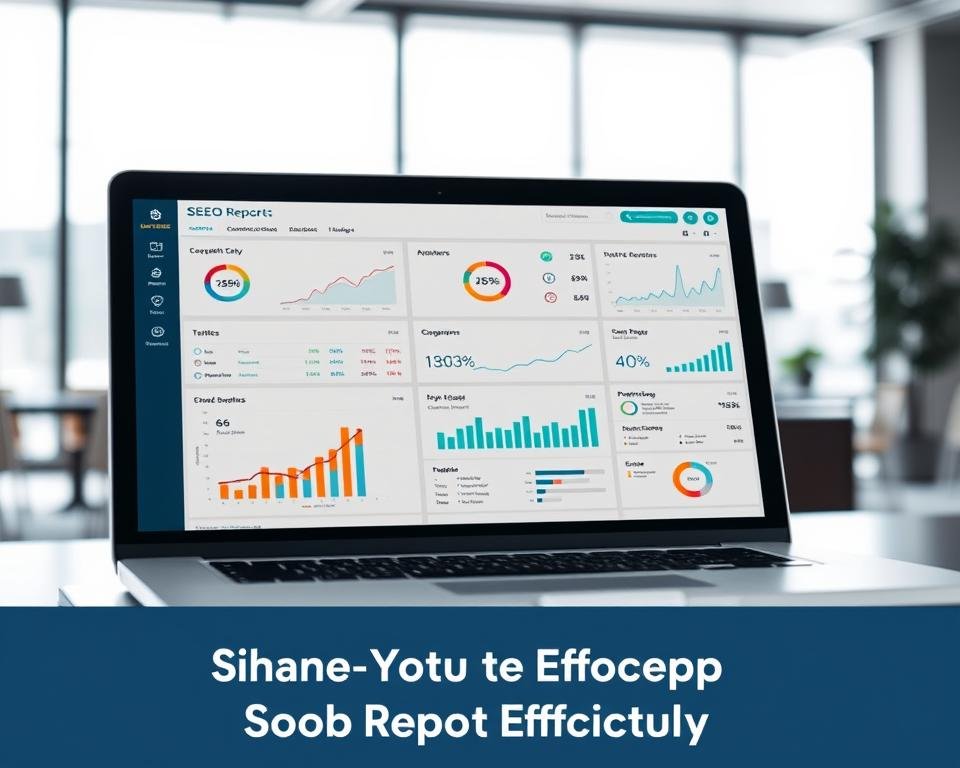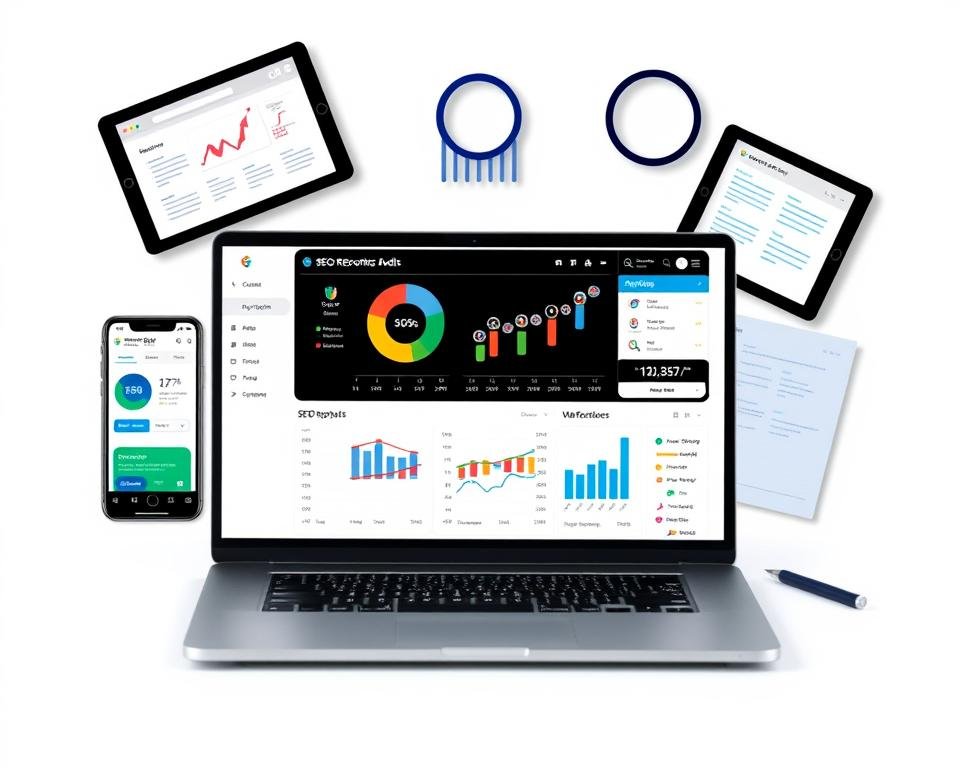As a website owner or digital marketer, tracking your site’s performance is key. I know how vital SEO reports are for making smart choices. In this article, I’ll show you how to make detailed SEO reports with free tools.
We’ll look at important metrics, the top free tools, and how to share your data well. By the end, you’ll know how to make great SEO reports.
Key Takeaways
- Understand the importance of SEO reports for your website’s performance.
- Learn how to choose the right free tools for SEO reporting.
- Discover key metrics to include in your SEO reports.
- Analyze and present your data effectively.
- Create detailed SEO reports using free tools.
Understanding the Importance of SEO Reports
SEO reports are key in today’s digital world. They help businesses see how their website does online. Knowing how your site ranks with search engines is vital for your strategy.
What is an SEO Report?
An SEO report shows how well a website ranks with search engines. It looks at organic traffic, keyword rankings, and backlink profile. These reports highlight what’s working and what needs work.
SEO reports include important data. This data helps businesses see their site’s online presence. It guides them in making smart SEO choices.
Why SEO Reports Matter for Businesses
SEO reports are vital for businesses. They offer insights into a website’s performance. This lets businesses spot and fix weak spots in their strategy.
Here’s why SEO reports are important:
- They show a website’s online presence and trustworthiness.
- They reveal how users interact with the site.
- They help track the success of SEO efforts.
- They guide data-driven decisions for future SEO plans.
Let’s look at a table comparing two websites’ SEO performance:
| Metric | Website A | Website B |
|---|---|---|
| Organic Traffic | 10,000 visits | 5,000 visits |
| Keyword Rankings | Top 3 for 5 keywords | Top 10 for 2 keywords |
| Backlink Profile | 500 backlinks | 200 backlinks |
By looking at this data, businesses can understand their SEO better. They can then make smart choices to boost their online presence.
Key Metrics to Include in Your SEO Report
When making an SEO report, pick the right metrics to see how your site is doing. The right data shows your site’s good points and areas to work on. This helps you make smart choices to boost your SEO.
Organic Traffic
Organic traffic shows how many people visit your site from search engines. Tracking organic traffic shows if your SEO is working. It helps spot trends, chances, and problems.
Keyword Rankings
Watching keyword rankings is key to seeing your site in search results. By tracking your keywords, you see if your SEO is working. You can then tweak your strategy as needed.
Backlink Profile
Your backlink profile is a big part of your SEO. Analyzing your backlinks shows the quality and number of links to your site. This info helps find link building chances and avoid bad links.
Site Performance
Site performance, like page speed and mobile friendliness, is important for SEO. By making your site faster and more mobile-friendly, you help users and search engines. Tracking site performance shows where to improve and checks if your efforts are working.
Adding these key metrics to your SEO report gives a full view of your site’s SEO. It helps make choices based on data. Good SEO performance tracking and SEO data analysis are key for keeping your site optimized.
Free Tools for SEO Reporting
Now, making SEO reports is super easy thanks to free tools online. These tools help you see how your website is doing. This info can help you make your SEO better.
Some top free tools for SEO reporting are:
Google Analytics
Google Analytics gives you deep insights into your website’s visitors. It shows you how people interact with your site. This helps you track your SEO efforts and make smart choices.
Google Search Console
Google Search Console is key for SEO reporting. It lets you check your site’s ranking and find any problems. This helps you make your site better for search engines.
Ubersuggest
Ubersuggest is great for finding keywords and content ideas. It also does SEO audits. It’s a big help for boosting your SEO.
AnswerThePublic
AnswerThePublic shows you what people search for online. Knowing this helps you make content that people want to read.
| Tool | Primary Function | SEO Benefit |
|---|---|---|
| Google Analytics | Traffic and Engagement Analysis | Understand user behavior and track SEO progress |
| Google Search Console | Search Engine Ranking Monitoring | Identify technical issues and optimize site performance |
| Ubersuggest | Keyword Suggestions and SEO Audits | Improve SEO strategy with data-driven insights |
| AnswerThePublic | Content Ideas and Topic Research | Create relevant content that resonates with your audience |
Using these free SEO tools, you can make detailed reports. These reports help you improve your SEO. You can track traffic, check keyword rankings, or find new content ideas. These tools give you the info you need to do well.
How to Analyze Traffic with Google Analytics
To make your website better, you need to check your traffic with Google Analytics. It’s a strong SEO analytics tool. Learning Google Analytics helps you understand your website’s traffic and how users act. This lets you make smart choices to boost your SEO.
Setting Up Goals and Conversions
Google Analytics lets you track important actions on your site, like form submissions or purchases. Here’s how to set up goals:
- Navigate to the “Admin” section in Google Analytics.
- Select “Goals” under the “View” column.
- Click on “New Goal” and choose a goal template or create a custom goal.
- Configure the goal details, such as the goal name, type, and destination URL.
- Save your goal and verify its configuration.
Setting up goals and conversions helps you see how well your SEO works. It shows you where you can get better.
Interpreting User Behavior Reports
Google Analytics has many reports on user behavior. These reports are key:
- Behavior Flow Report: Shows how users move through your site. It helps you find where people leave and how to keep them.
- Site Content Report: Tells you which pages are most visited and how people interact with them.
- Events Report: Tracks specific actions on your site, like button clicks or video plays.
Understanding these reports helps you know how users behave. This lets you make your site better for them and increase sales.
Keyword Research Using Free Tools
Keyword research is key for a good SEO plan. It helps you find the right words to use. This makes your website more visible and brings in more visitors.
There are many free tools to help with keyword research. They give you insights into how well keywords work and suggest new ones.
Finding the Right Keywords with Ubersuggest
Ubersuggest is a great tool for finding keywords. Here’s how to use it:
- Put a keyword or phrase into the search bar.
- Look at the suggested keywords and their stats, like search volume and competition.
- Pick keywords that fit your content and have good search numbers.
Ubersuggest also shows you different versions of keywords. This helps you make your list better.
Utilizing Google Keyword Planner
Google Keyword Planner is another must-have for keyword research. It lets you:
- Enter keywords and get suggestions for more.
- See how often people search for your keywords and how competitive they are.
- Find new keywords to add to your SEO plan.
Using these free tools, you can make a strong keyword strategy. This boosts your website’s visibility and attracts more visitors.
By using Ubersuggest and Google Keyword Planner together, you can make a solid SEO plan. It includes:
- Relevant Keywords: Find and use keywords that match your content well.
- Keyword Variations: Use different versions of your keywords to reach more people.
- Content Optimization: Use your keywords in your website’s content to rank better in search results.
Backlink Analysis with Free Tools
Backlink analysis is key for SEO performance tracking. It helps you see your website’s backlink profile. This lets you find ways to boost your SEO and get more online visibility.
Overview of Backlink Checker Tools
Many free tools can help with backlink analysis. Some top picks include:
- Ahrefs Backlink Checker: It gives deep insights into your website’s backlink profile.
- Moz Open Site Explorer: This tool lets you check your website’s backlinks and anchor text.
- SEMrush Backlink Analytics: It offers a detailed look at your website’s backlinks, like referring domains and anchor text.
These tools help you understand your website’s backlink profile. They show you where you can improve.

Assessing Link Quality
Not all backlinks are the same. It’s important to check the quality of your website’s backlinks. This helps you see how they affect your SEO.
When looking at link quality, think about these things:
- Relevance: Is the linking page related to your content?
- Authority: Is the linking domain trustworthy and authoritative?
- Anchor text: Is the anchor text clear and relevant?
By looking at these, you can judge your website’s backlink quality. This helps you find ways to better your SEO strategy.
Creating Visuals for Your SEO Report
To make your SEO report stand out, adding visuals is key. They help show complex data clearly and simply. Visuals are important for making your report easy to read and understand.
Charts, graphs, and infographics can make complex data simple. They help stakeholders see how your website is doing. With these visuals, you can share your findings and suggestions well.
Incorporating Charts and Graphs
Charts and graphs are great for showing data in a nice way. Use line charts for trends, bar charts for comparisons, and pie charts for parts. These tools make your data fun to look at and easy to get.
For example, a line chart can show changes in organic traffic. A bar chart can compare different keywords’ traffic. These visuals make your data more fun and simple to understand.
Using Canva for Report Design
Canva is a great tool for making reports look good. It’s easy to use and has lots of templates. You don’t need to be a designer to make your reports look professional.
To make an SEO report in Canva, pick a template that fits your brand. Then, add your data, charts, and graphs. Canva’s drag-and-drop editor lets you add text, images, and more to your report.
Using Canva for your SEO report has many benefits. You get:
- Many customizable templates, including SEO report ones
- An easy-to-use interface for professional-looking reports
- The chance to work with your team in real-time
Adding visuals to your SEO report makes your data more engaging. It’s easier to understand and shows your website’s performance well to stakeholders.
Compiling Your Findings into a Report
Putting your SEO findings into a report is key. It helps you share your website’s performance with others. You need to organize your data well. This makes your report clear and easy to read.
Structuring Your Report
A good report is all about clear communication. Here are some tips:
- Introduction: Start with a brief overview of your report’s purpose.
- Methodology: Explain how you collected your data.
- Key Findings: Share your main discoveries with charts and graphs.
- Analysis: Talk about what your findings mean, pointing out good and bad points.
- Recommendations: Give tips on how to improve.
- Conclusion: Sum up the main points and what they mean for the future.
Think about who will read your report. Make it fit their level of knowledge and interest.
Adding Executive Summaries
An executive summary is a quick look at your report’s main points. It should give a quick view of your website’s performance and key info.
Here’s how to write a good executive summary:
- Keep it short: Aim for one or two pages.
- Focus on important data: Highlight things like traffic and rankings.
- Use simple language: Stay away from hard terms that might confuse people.
Here’s an example of how to show your data in a table:
| Metric | Current Value | Previous Value | Change |
|---|---|---|---|
| Organic Traffic | 10,000 | 8,000 | +25% |
| Keyword Rankings | 50 | 40 | +25% |
| Backlinks | 500 | 450 | +11% |
By making your data easy to see, you help others understand your website’s performance. This makes it easier for them to make good choices.
Sharing Your SEO Report Effectively
After you’ve made your SEO report, it’s time to share it. Share it well with your team and others. This way, they can understand and use your findings to improve your website’s SEO.
Best Formats for Reports
Picking the best format for your SEO report is key. You can use PDF, HTML, or interactive dashboards. PDF reports are popular because they’re easy to share and look the same everywhere.
| Format | Advantages | Disadvantages |
|---|---|---|
| Consistent formatting, easy to share | Not interactive | |
| HTML | Interactive, can include links | May not display consistently across devices |
| Interactive Dashboards | Highly interactive, real-time data | Requires specific tools, can be complex |
Utilizing Email and Cloud Storage
Email is a top choice for sharing reports, great for those who aren’t tech-savvy. Cloud storage like Google Drive or Dropbox is also good. It lets people view and interact with your reports online.

When emailing, try to send smaller files or links to cloud storage. This helps avoid size issues. Also, include a quick summary in the email to highlight the most important points.
By picking the right format and sharing method, your SEO report will get through. And it will be understood and used by your team and stakeholders.
Regularly Updating Your SEO Reports
It’s important to update your SEO reports often. This lets you see how your website is doing over time. You can spot trends and make smart choices to boost your SEO performance tracking.
Being consistent with your SEO reports is key. It helps you keep track of your progress. You can find out what needs work and change your plan as needed.
Why Consistency is Key
Staying consistent with your SEO reports is vital. It lets you:
- Watch how your website’s traffic and rankings change
- See how algorithm updates affect your site
- Check if your SEO plans are working
By keeping your reports up to date, you can tweak your SEO strategy. This way, you make choices based on solid data.
Setting a Reporting Schedule
To keep your SEO reporting consistent, set a schedule. This could be every week, month, or quarter. It depends on your site’s needs and how often things change.
When picking a schedule, think about these points:
| Reporting Frequency | Benefits | Drawbacks |
|---|---|---|
| Weekly | Tracks changes closely | Can be time-consuming, might feel overwhelmed |
| Monthly | Gives a good view of performance, easier to handle | May miss sudden changes |
| Quarterly | Looks at long-term trends, less work | Not good for fast-changing sites |
Pick a schedule that fits your needs and resources. The goal is to stay informed without getting lost in too much detail.
Learning from Your SEO Reports
SEO reporting is powerful because it helps improve your online marketing. It shows you what works and what doesn’t on your website. This knowledge helps you make your SEO better.
Identifying Areas of Improvement
SEO reports point out what needs work. They look at things like how many people visit your site and how well your content ranks. If fewer people visit, you might need to change your content or make your site easier to use.
Key areas to focus on include:
- Technical SEO issues, such as site speed and mobile responsiveness
- Content quality and relevance
- Link building and outreach efforts
Making Data-Driven Decisions
SEO reports help you make smart choices online. They give you insights to adjust your SEO strategy. For example, if people are searching for new things, you can update your content.
To make good choices, follow these steps:
- Regularly review your SEO reports to stay up-to-date on your website’s performance
- Use free SEO reporting tools to streamline your analysis and identify trends
- Adjust your SEO strategy based on the insights gained from your reports
Conclusion: Enhancing Your SEO Strategy
Creating SEO reports with free tools is key for website owners and digital marketers. By following this guide, you can make detailed reports. These reports help shape your SEO strategy for lasting success.
Key Takeaways
We talked about why SEO reports matter, what metrics to track, and free tools for reporting. We also covered analyzing traffic, keyword research, and making your report visually appealing. By using these , you can boost your SEO strategy and improve your site’s performance.
Ongoing Optimization
To keep improving your site, update your SEO reports often. Use tools like Google Analytics and Ubersuggest to track your progress. This way, you can fine-tune your SEO reporting skills and reach your online marketing goals.
